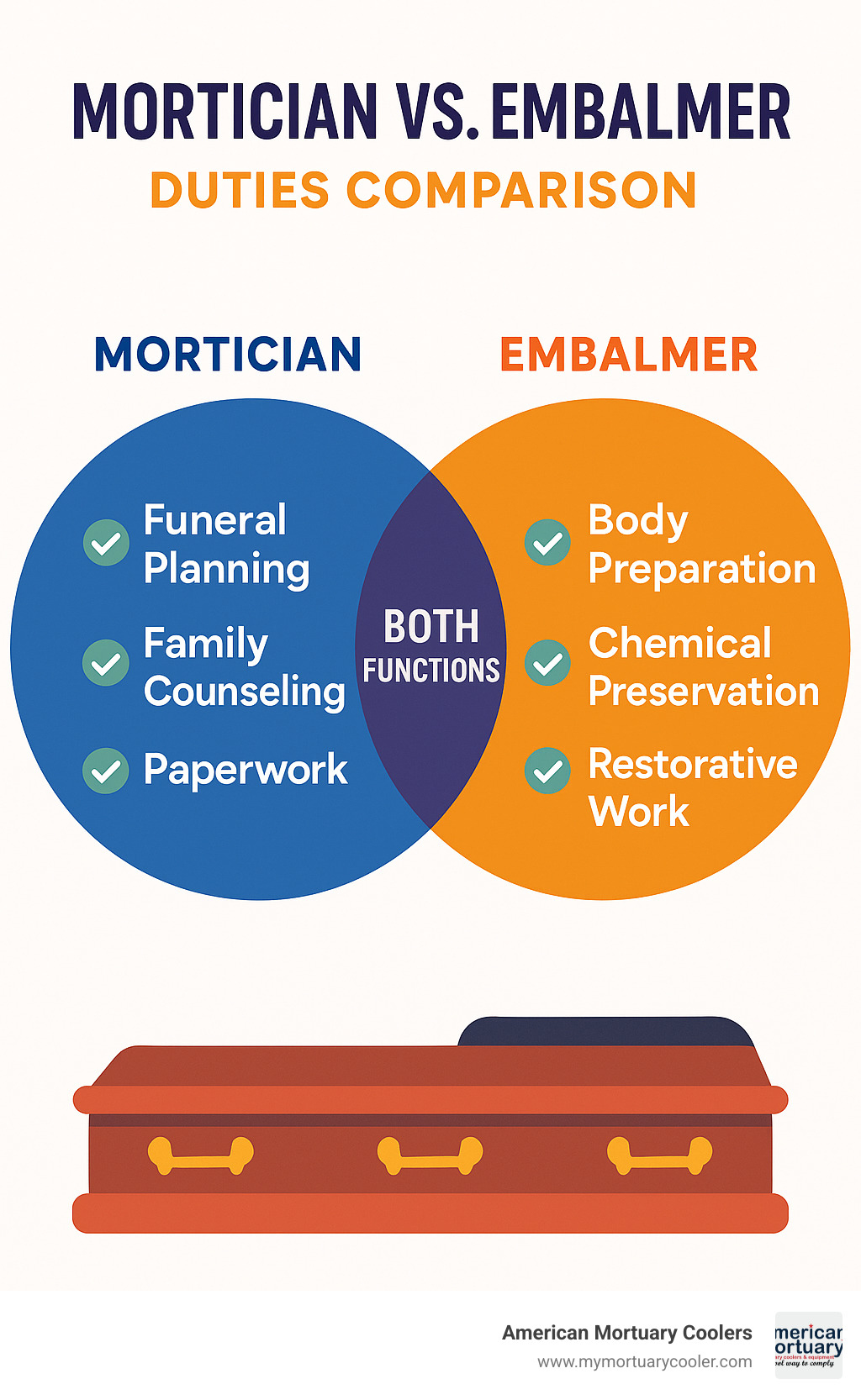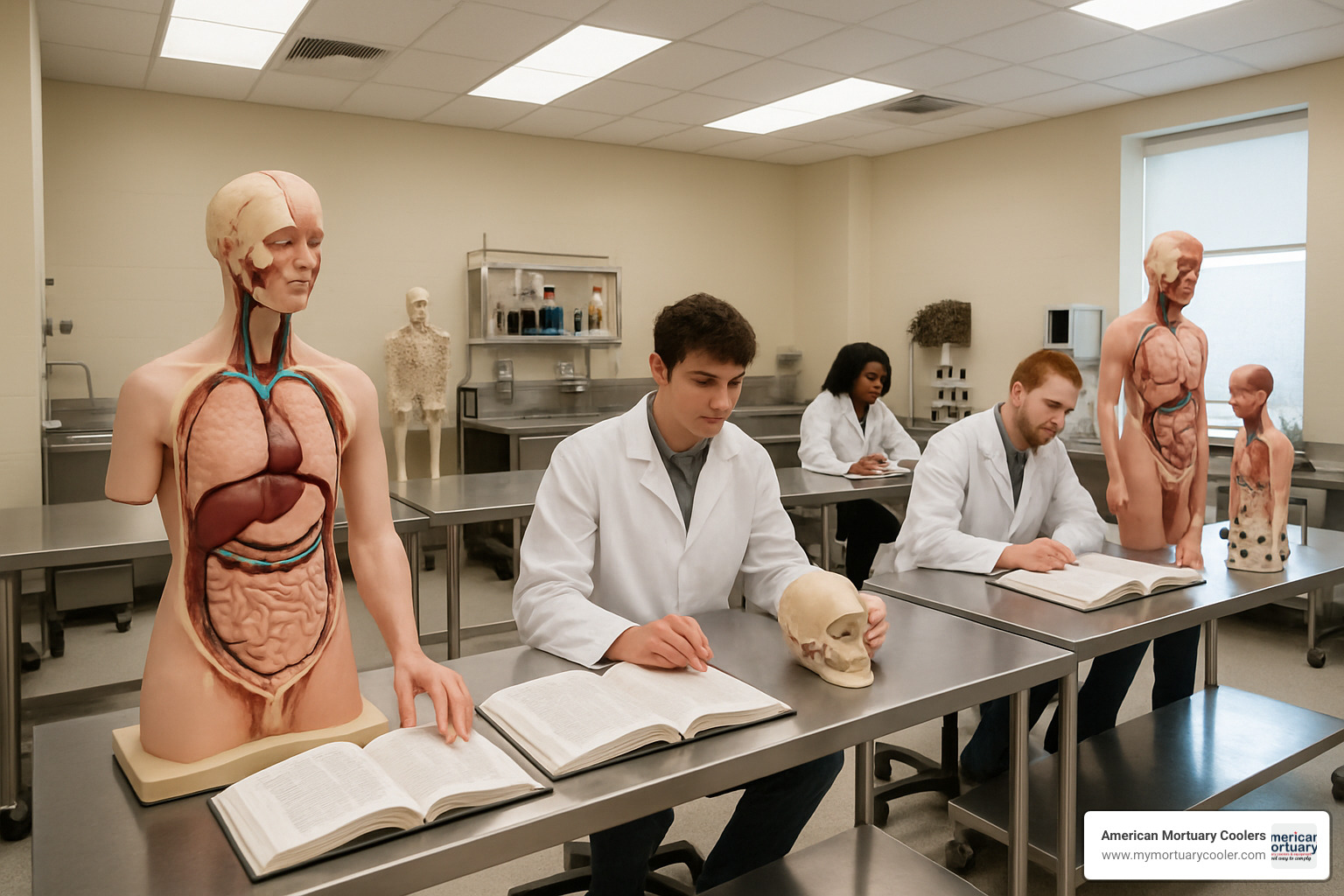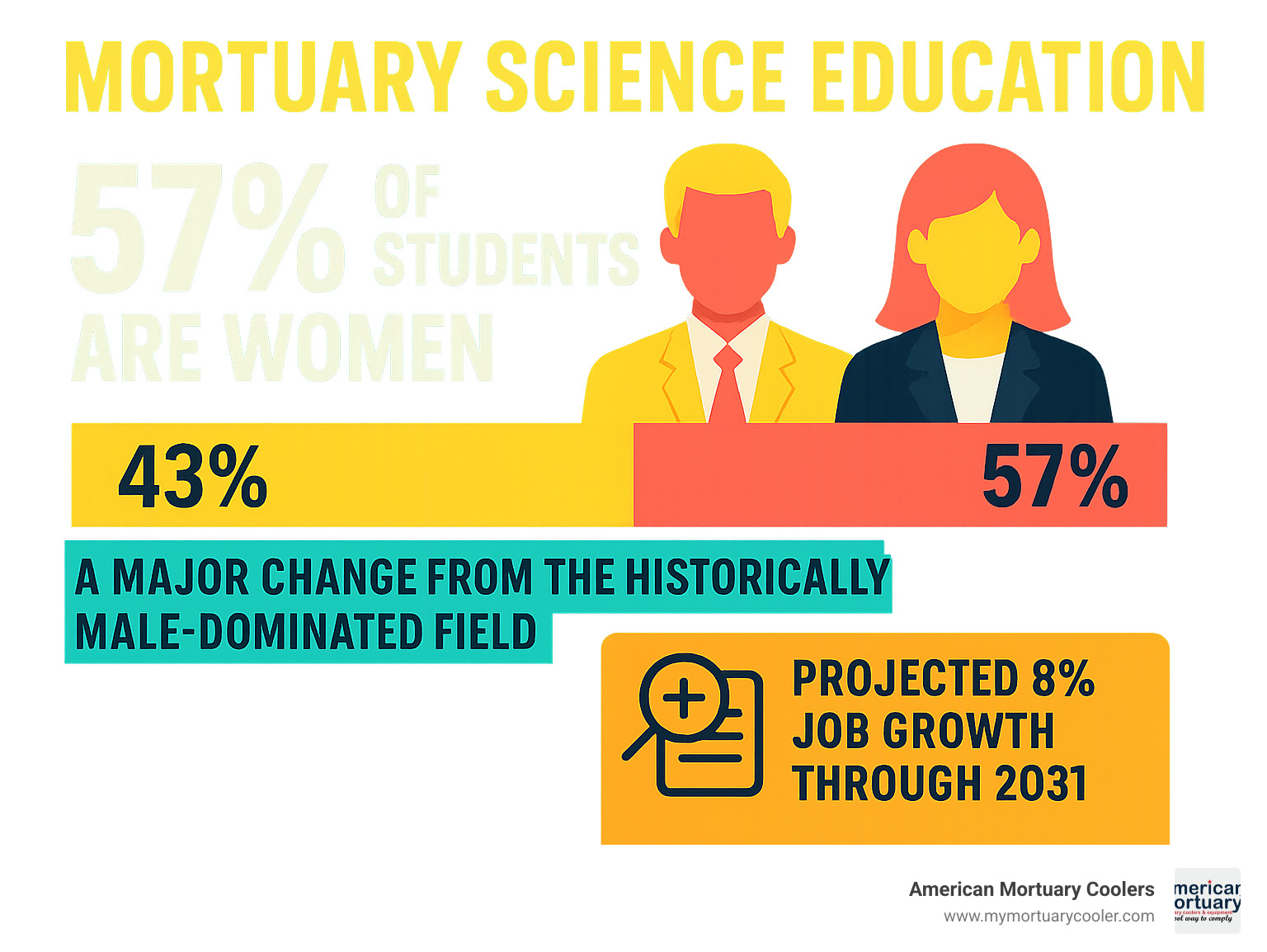
The Ultimate Guide to Whether a Mortician and Embalmer Are the Same
Why Understanding Funeral Service Roles Matters
Is a mortician and embalmer the same profession? The short answer is: they overlap significantly but aren't identical. Here's what you need to know:
Quick Answer:
- Mortician = arranges funerals, supports families, handles paperwork
- Embalmer = preserves bodies using chemicals, performs restorative work
- Same person can do both with proper licensing
- Terms often used interchangeably in everyday conversation
- Licensing requirements vary by state
Most funeral professionals today hold licenses for both roles. The confusion stems from decades of evolving terminology - "undertaker" became "mortician" in 1895, while "funeral director" gained popularity after 1905.
The funeral industry has seen major changes recently. Women now comprise 57% of mortuary school students, completely shifting what was once a male-dominated field. This growth reflects increasing demand for funeral services as the population ages.
Understanding these distinctions matters whether you're considering a career change, hiring staff, or simply want to use the right terminology when working with funeral professionals.
As American Mortuary Coolers, a national-level mortuary cooler supplier with experience in the funeral industry, we've worked closely with both morticians and embalmers to understand how is a mortician and embalmer the same question affects equipment needs and facility planning. Our background in mortuary equipment has given us insight into how these roles overlap in daily practice and what tools each professional requires.

Mortician vs. Embalmer: Core Roles & Day-to-Day Duties

Walking into a funeral home, you might wonder: is a mortician and embalmer the same person handling everything? The answer often depends on the size of the facility and how they structure their staff.
Picture Sarah, who starts her morning reviewing death certificates and coordinating with three different cemeteries. By 10 AM, she's switched gears completely - now she's in the preparation room, carefully selecting chemical formulations for preservation work. After lunch, she'll meet with a grieving family to plan their loved one's memorial service.
Sarah represents the modern funeral professional who wears multiple hats. She holds licenses for both mortician and embalmer duties, which has become increasingly common as funeral homes adapt to staffing challenges and changing family needs.
The daily reality reveals how these roles naturally complement each other. Body preparation work requires scientific precision and technical skill, while service planning demands emotional intelligence and organizational abilities. Many professionals find that understanding both sides makes them better at their job overall.
Grief support often bridges both roles - embalmers frequently interact with families during viewings, while morticians need to understand preservation processes to answer family questions accurately. The funeral director overlap means most staff members today develop skills across multiple areas.
For deeper insights into these daily responsibilities, our team has compiled resources about a day in the life of a mortician and created a practical guide to mortuary embalming and how it works.
Mortician Defined
A mortician serves as the heart of funeral home operations, focusing on logistics, counseling, and ceremony orchestration. Think of them as part event planner, part counselor, and part business manager.
The logistics side involves a surprising amount of paperwork and coordination. Morticians spend significant time obtaining death certificates, scheduling with cemeteries, and managing transportation arrangements. They handle insurance claims, coordinate with clergy, and ensure all legal requirements are met. It's detail-oriented work that families rarely see but absolutely depends on.
Counseling forms the emotional core of mortician work. These professionals guide families through some of their most difficult decisions - burial versus cremation, service styles, and budget considerations. They write obituaries with families, explain various options with patience, and provide ongoing grief support. The ability to remain calm and compassionate during highly emotional situations is essential.
Ceremony orchestration brings everything together for the actual services. Morticians coordinate with florists, musicians, and caterers. They oversee funeral processions, manage viewing hours, and ensure cultural or religious requirements are properly honored. Every detail matters when families are saying their final goodbyes.
The median salary for morticians was $54,100 in 2020, reflecting both the responsibility level and emotional demands these professionals handle daily.
Embalmer Defined
Embalmers work behind the scenes, specializing in chemical preservation, sanitization, and restorative art. Their work requires both scientific knowledge and artistic skill to achieve results that bring comfort to families.
Chemical preservation forms the technical foundation of embalming work. Embalmers remove bodily fluids and replace them with carefully selected embalming solutions. They must understand decomposition processes, chemical interactions, and how different formulations work for various situations. Proper documentation and safety protocols are critical aspects of this scientific work.
Sanitization requirements are extensive and non-negotiable. Embalmers follow strict health regulations, maintain sterile working conditions, and handle infectious disease protocols. They properly dispose of biological materials and ensure preparation areas meet all safety standards. This aspect of the work protects both funeral home staff and the families they serve.
Restorative art combines science with creativity to help families remember their loved ones peacefully. Embalmers reconstruct damaged tissue, apply cosmetics for natural appearance, and position bodies with dignity. This delicate work requires specialized tools and techniques, plus an understanding of what brings comfort to grieving families.
Most states require separate licensing for embalming work, with additional training beyond basic mortuary science education. The combination of technical expertise and emotional sensitivity makes skilled embalmers highly valued in the funeral industry.
Is a Mortician and Embalmer the Same?
Is a mortician and embalmer the same profession? It's one of those questions that seems simple but gets complicated fast. The honest answer is that these roles overlap so much that many people - including those in the industry - use the terms interchangeably in everyday conversation.
But here's where it gets interesting: while they're often the same person, they're not technically the same job. Think of it like a chef who also manages the restaurant. They might wear both hats, but cooking and managing require different skills and focus areas.
The confusion comes from how the funeral industry actually works. In smaller funeral homes, one person typically handles everything - they'll embalm a body in the morning, meet with a grieving family in the afternoon, and coordinate a funeral service the next day. But larger establishments often employ specialists who focus on either the technical body preparation work or the family service coordination side of the business.
Professional specialization has grown significantly since the 1970s and 80s, when many states began requiring separate licenses for funeral directing and embalming. This shift happened because the industry recognized these roles need different skill sets - one focuses heavily on science and technical precision, while the other emphasizes service and emotional support.
Public perception adds another layer to this puzzle. Most people outside the industry don't realize there's a distinction at all. They use "mortician," "embalmer," and "funeral director" as if they all mean the same thing, which honestly makes sense from their perspective.
| Aspect | Mortician | Embalmer |
|---|---|---|
| Primary Tasks | Service planning, family counseling, logistics | Body preparation, chemical preservation, restoration |
| Tools Used | Computers, phones, office equipment | Embalming machines, chemicals, surgical instruments |
| Client Interaction | High - constant family contact | Low - primarily technical work |
| Required Skills | Communication, organization, empathy | Chemistry, anatomy, technical precision |
| Work Environment | Office, chapel, meeting rooms | Preparation room, laboratory setting |
| Licensing | Funeral director license | Embalmer license (often separate) |
Key Differences: is a mortician and embalmer the same?
The biggest differences between morticians and embalmers come down to three main areas: what the state requires for licensing, how they spend their typical workday, and what kind of expertise they need.
Regulatory scope varies dramatically by state. Most maintain separate licensing requirements because they recognize these roles need different competencies. Funeral director licenses focus on business practices, grief counseling, and service coordination. Embalmer licenses emphasize anatomy, chemistry, and preservation techniques. It's like having separate licenses for driving a car versus operating heavy machinery - related but distinct.
The viewings versus paperwork distinction really shows the difference in daily life. Morticians spend most of their time handling administrative tasks and family interactions - death certificates, cemetery coordination, funeral home operations, and ongoing family support. Embalmers work primarily in prep rooms with specialized equipment and chemicals, focusing on the technical preparation of remains.
Then there's the science versus service divide. Morticians need strong interpersonal skills, business knowledge, and understanding of funeral customs. Embalmers require deep knowledge of human anatomy, chemistry, and preservation science. Both need compassion and attention to detail, but they apply these qualities very differently throughout their workday.
These differences explain why some professionals choose to specialize in one area while others pursue dual licensure for maximum career flexibility and earning potential.
State Licensing: is a mortician and embalmer the same career path?
Whether is a mortician and embalmer the same career path depends entirely on where you live and work. State licensing requirements tell the real story here, and it varies significantly across the United States.
Most states require separate licenses for funeral directing and embalming. This means completing distinct educational requirements, apprenticeships, and examinations for each role. States like California, Texas, and New York maintain strict separation between these licenses, treating them as related but separate professions.
However, some states offer combined licenses that allow professionals to perform both functions under one credential. These jurisdictions recognize the practical reality that smaller funeral homes need staff who can handle all responsibilities seamlessly.
Apprenticeship requirements also differ by state and license type. Funeral director apprenticeships typically range from one to three years, focusing on business operations, family counseling, and service coordination. Embalming apprenticeships emphasize hands-on technical training in body preparation and preservation methods.
The apprenticeship process requires working under licensed professionals who provide mentorship in both technical skills and professional ethics. Many apprentices work in funeral homes that handle both functions, giving them exposure to the full range of funeral service responsibilities - which often helps them decide whether to specialize or pursue dual licensure.
For current licensing requirements in your specific state, check the Latest licensing map for funeral professions to understand the educational and examination requirements that apply to your situation.
Education, Apprenticeship & Certification Requirements

Getting into funeral service requires dedication, but the path is more straightforward than you might think. Whether you're wondering is a mortician and embalmer the same educational journey, the answer is mostly yes - both professionals start with similar foundational training.
Mortuary science education has come a long way from the old apprentice-only days. Today's programs blend science, psychology, and business skills to prepare well-rounded professionals. The curriculum reflects what we've learned about grief support, advanced preservation techniques, and modern funeral home operations.
Most students begin their journey at ABFSE-accredited programs - that's the American Board of Funeral Service Education. These schools have met strict standards for faculty, facilities, and curriculum. Without ABFSE accreditation, you typically can't sit for licensing exams, so this accreditation matters.
The big decision early on is choosing between an associate degree (2 years) or bachelor's degree (4 years) program. Associate programs cover all the essentials and get you working faster. Bachelor's programs dive deeper into management, advanced restoration, and specialized areas like forensic techniques.
Here's what surprised many students: mortuary science programs are surprisingly diverse. You'll study anatomy and chemistry for embalming work, psychology and counseling for family support, and business and law for funeral home operations. It's like getting three different educations rolled into one.
Apprenticeship training bridges the gap between classroom and career. This hands-on period lasts 1-3 years depending on your state. You'll work under experienced professionals who teach you everything from proper embalming techniques to handling difficult family situations. Many apprentices find whether they prefer the technical embalming work or the family-facing mortician duties during this time.
The national board exam tests everything you've learned. Most states accept scores from the International Conference of Funeral Service Examining Boards, though some maintain their own testing requirements. These comprehensive exams cover both book knowledge and practical skills.
Continuing education keeps professionals current throughout their careers. New preservation methods, updated regulations, and evolving grief counseling approaches require ongoing learning. Most states require 10-20 hours annually, though many professionals exceed these minimums.
For detailed guidance on educational pathways, check out The Ultimate Guide to a Mortuary Science Bachelor's Degree and explore Scientific research on embalming chemistry for the latest developments in the field.
From Undertaker to Funeral Director: History, Regions & Terminology

Ever wonder why your grandmother calls them "undertakers" while your neighbor uses "funeral director"? The confusion around is a mortician and embalmer the same stems partly from centuries of evolving terminology in the funeral industry.
Undertaker Origins: Back in the 1400s, an "undertaker" was simply someone who "undertook" various jobs - from building furniture to hauling goods. By the 1690s, the term stuck specifically to funeral services. These early undertakers were often furniture makers who built coffins or livery stable operators who provided hearses.
The job was pretty straightforward back then. Pick up the deceased, provide a wooden box, arrange the burial. No fancy preservation techniques, elaborate ceremonies, or grief counseling sessions.
Civil War Embalming Boom: Everything changed during the American Civil War. President Lincoln's death in 1865 became a turning point for the entire industry. Lincoln's embalmed body traveled 1,645 miles by train, allowing Americans across the country to pay their respects. This public demonstration showed people that bodies could be preserved effectively.
The war created massive demand for bringing soldiers' bodies home to their families. Embalmers developed new techniques and chemicals, including formaldehyde in the late 1880s. This period established embalming as a distinct technical specialty - separate from the general funeral arrangements.
1895 "Mortician" Rebrand: Here's where things get interesting. The funeral industry got tired of the negative image surrounding "undertaker." In 1895, The Embalmers' Monthly magazine actually held a contest to find a better professional title. "Mortician" won because it sounded dignified - like "physician."
This wasn't just about vanity. Funeral professionals wanted recognition as skilled practitioners providing essential services, not just tradesmen who handled dead bodies. The rebranding worked, and "mortician" became widely accepted.
Modern Funeral Director: "Funeral director" emerged after the British Undertakers' Association rebranded as the National Association of Funeral Directors in 1905. This term emphasized the management and coordination aspects rather than just handling remains.
Today, most industry professionals prefer "funeral director." It reflects their modern role as service coordinators, grief counselors, and business managers. The title captures the full scope of contemporary funeral service.
Regional Variations: Where you live often determines which term you hear most. "Undertaker" remains popular in rural areas and among older generations. "Mortician" is widely recognized but considered somewhat dated by professionals. "Funeral director" dominates in professional contexts and urban areas.
These regional preferences explain why people use these terms interchangeably without realizing that professionals might have specific preferences or that different terms can indicate different specializations.
The terminology evolution shows how the industry has professionalized over time. Understanding this history helps answer is a mortician and embalmer the same - these roles developed from the same roots but branched into distinct specializations as the profession grew more complex.
For fascinating details about terminology evolution, read about How the term 'mortician' was invented.
Frequently Asked Questions About Morticians & Embalmers
Are morticians doctors?
This common question reflects confusion about professional credentials and educational requirements. Morticians are not medical doctors, though they do require specialized education and licensing.
Educational Requirements: Morticians typically hold associate or bachelor's degrees in mortuary science, not medical degrees. Their education focuses on funeral service, grief counseling, business practices, and basic anatomy rather than medical diagnosis and treatment.
Professional Credentials: Licensed morticians must pass state or national examinations and complete supervised apprenticeships. While rigorous, this training differs significantly from medical school and residency requirements for physicians.
Scope of Practice: Morticians cannot diagnose illness, prescribe medications, or provide medical treatment. Their role focuses on post-death care, family support, and funeral coordination. Any medical determinations about cause of death fall under the jurisdiction of medical examiners or coroners.
For detailed information about mortician qualifications, see our comprehensive guide: Are Morticians Doctors?.
Can one professional hold both licenses?
Yes, many funeral service professionals hold both mortician (funeral director) and embalmer licenses. This dual licensure offers significant advantages in terms of career flexibility and employment opportunities.
Benefits of Dual Licensure:
- Greater employment flexibility and job security
- Ability to work independently in smaller funeral homes
- Higher earning potential due to expanded skill set
- Better understanding of all aspects of funeral service
- Increased value to employers who need versatile staff
Training Requirements: Obtaining both licenses typically requires completing comprehensive mortuary science education that covers both areas, plus separate apprenticeships or extended apprenticeship periods that provide experience in both functions.
Career Considerations: While dual licensure requires more time and effort initially, it provides long-term career advantages. Many successful funeral home owners and managers hold both licenses, allowing them to understand and oversee all aspects of their operations.
Which title is most common today?
"Funeral director" has become the preferred professional title in most contexts, though usage varies by region and situation.
Professional Preference: Within the funeral industry, "funeral director" is considered the most modern and appropriate term. It emphasizes the coordination and management aspects of the role while avoiding potentially negative connotations associated with older terms.
Public Usage: The general public often uses "mortician," "undertaker," and "funeral director" interchangeably. Regional traditions and generational differences influence which terms people naturally use.
Branding Trends: Modern funeral homes typically use "funeral director" in their marketing and professional communications. This choice reflects efforts to emphasize service, professionalism, and family support rather than just handling of remains.
The trend toward "funeral director" also reflects the evolution of the profession from primarily technical work to comprehensive family service that includes grief counseling, ceremony planning, and ongoing support.

Conclusion & Next Steps
Understanding whether is a mortician and embalmer the same profession requires recognizing both the similarities and distinctions between these essential roles in funeral service. While the terms are often used interchangeably in everyday conversation, they represent different specializations within the broader funeral industry.
Key Takeaways:
- Morticians focus on family services, logistics, and ceremony coordination
- Embalmers specialize in body preparation, preservation, and restoration
- Many professionals hold dual licenses and perform both functions
- State licensing requirements vary significantly across jurisdictions
- Educational pathways emphasize different skill sets for each specialization
Career Clarity Matters: Whether you're considering entering the funeral profession, hiring staff for a funeral home, or simply want to understand the professionals serving your community, these distinctions matter. The funeral industry continues evolving, with 57% of mortuary school students now being women and projected 8% job growth through 2031.
Equipment and Facility Considerations: At American Mortuary Coolers, we understand how these role distinctions affect equipment needs and facility planning. Morticians primarily need office equipment, meeting spaces, and family comfort areas. Embalmers require specialized prep room equipment, including mortuary coolers, embalming machines, and chemical storage systems.
Our custom mortuary coolers serve both types of professionals, providing reliable preservation solutions that support quality funeral service regardless of whether facilities employ specialists or dual-licensed practitioners. With direct delivery across the contiguous 48 states from our Tennessee base, we help funeral homes in every region maintain the equipment standards their professionals need.
Compliance Importance: Understanding professional distinctions also matters for regulatory compliance. Funeral homes must ensure staff hold appropriate licenses for their assigned duties and that facilities meet requirements for both funeral directing and embalming operations when applicable.
Explore More Resources: The funeral profession offers rewarding career opportunities for those called to serve families during difficult times. Whether pursuing mortician, embalmer, or dual credentials, proper education and equipment support are essential for success.
For more information about mortuary equipment and career resources, visit More info about mortuary coolers and career tools to explore how we support funeral professionals across all specializations and regions.
The funeral industry will continue evolving, but the fundamental need for compassionate, skilled professionals who can provide both technical expertise and emotional support remains constant. Understanding the distinctions and connections between morticians and embalmers helps ensure this vital profession continues serving families with dignity and professionalism.



